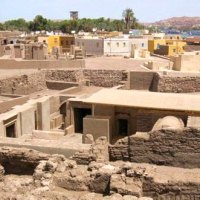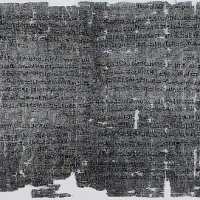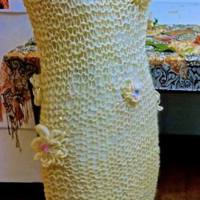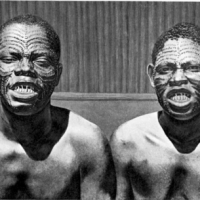Although Africa has and continues to be thought of as the Dark Continent that remained untouched until the advent of European explorers and colonizers, Arab–Swahili traders from the East Coast of Africa developed extensive commerce with the interior for several hundreds of years prior to European exploration and colonization.
Based out of a series of city states located on the East African coast, from Somalia through Tanzania, these Swahili traders, together with Arab traders from the Gulf, established settlements along the caravan routes into the interior, where they maintained their families, grew a variety of crops with seeds introduced from Indian and elsewhere, imported luxury items from Zanzibar and across the Indian Ocean, and lived a pretty good pre-(European) ‘colonial’ life.
For more on local leaders see: Sheikhs and Sultans of the Swahili ‘City-states’ – What Sir Burton had to Say
and: Sheikhs and Sultans of the Swahili ‘City-states’ – Stanley’s Experiences
For more on cuisines and crops see: Swahili ‘City States’ in 19th Century East Africa: Indigenous and Imported Crops

- Hamid bin Muhamad bin Said, Late Sultan of Zanzibar. A wealthy Swahili merchant, who would have been one of the go-betweens with the inland merchants. Davis – Africa… 1907
The primary goal of Swahili traders was mercantile-based commerce – not conquest or proselytizing. During the period of Swahili commercial activities, central Africa was linked to the East African coast by a network of caravan routes by head-transport [or ‘porters’] to the East African Swahili coast, where commerce then moved by boat to the Middle East as well as across the Indian Ocean.

Ivory and cloth porters
Except under threat of attack by local marauders, these Swahili commercial communities in Central Africa generally maintained a laissez-fare attitude towards their African neighbors and commercial partners, intermarrying as well as purchasing slaves, ivory and other items for which payment was made in kind. In turn, local populations along the caravan routes profited both by charging safe-passage levies as well as by provisioning the caravans with food and drink.
They also profited from a variety of imported goods – such as cloth, beads, copper wire and pepper – and also from [in-kind] profits made by selling slaves, ivory and other items, with local elites adopting some of the manners and dress of their Swahili partners – and vice-versa.

Shaykh of the Niam-Niam (Azande) of North-Central Africa
A variety of food crops were also adopted, that were initially brought in for cultivation by Arab-Swahili merchants, including maize, sweet potatoes, various fruit trees, etc. The Portuguese, who since the 16th Century were active along the coast and in intermittent conflict with Swahili city-states, would also have introduced crops from the New World as well as from India and Asia.
Some agricultural technologies, such as the shadduf water wheel and some irrigation techniques, were also imported by the Swahili:

shadufs were introduced from Egypt for raising water
As in West Africa, slaves were generally men and women who had been conquered in warfare. Purchased and taken to the coast by the Arab-Swahili, they were sold on to Arab, Portuguese and British slavers for boat transport to the Middle East. Ivory and other exotic items from Africa were similarly sold on to the Middle East as well as to India.

Ivory was transported from the interior to coastal ports for export to the Middle East and elsewhere. This shipment is going to Boston. Davis - Africa... 1907
Here are some passages from Stanley’s book that detail food, living, crops, etc. as related to Swahili settlements on the way to Lake Tanganyika. The account was written during his travel in the areas of Uganda, Rwanda, Tanzania, and Burundi [up to where we live on the North Shore of Lake Tanganyika, as a matter of fact].
Stanley, Henry M. How I Found Livingston. Travels, Adventures, and Discoveries in Central Africa . [Gutenberg]
[In Tanzania, on route towards Lake Tanganyika:]
… Just as I began to feel hungry again, came several slaves in succession, bearing trays full of good things from the Arabs; first an enormous dish of rice, with a bowlful of curried chicken, another with a dozen huge wheaten cakes, another with a plateful of smoking hot crullers, another with papaws, another with pomegranates and lemons; after these came men driving five fat hump-backed oxen, eight sheep, and ten goats, and another man with a dozen chickens, and a dozen fresh eggs. This was real, practical, noble courtesy, munificent hospitality, which quite took my gratitude by storm…
…My people, now reduced to twenty-five, were as delighted at the prodigal plenitude visible on my tables and in my yard, as I was myself. And as I saw their eyes light up at the unctuous anticipations presented to them by their riotous fancies, I ordered a bullock to be slaughtered and distributed…
…The second day of the arrival of the Expedition in the country which I now looked upon as classic ground, since Capts. Burton, Speke, and Grant years ago had visited it, and described it, came the Arab magnates from Tabora* to congratulate me…
(*Tabora is the principal Arab settlement in Central Africa. It contains over a thousand huts and tembes, and one may safely estimate the population, Arabs, Wangwana, and natives, at five thousand people. Between Tabora and the next settlement, Kwihara, rise two rugged hill ridges, separated from each other by a low saddle, over the top of which Tabora is always visible from Kwihara…)
… At Tabora they live quite luxuriously. The plain on which the settlement is situated is exceedingly fertile, though naked of trees; the rich pasturage it furnishes permits them to keep large herds of cattle and goats, from which they have an ample supply of milk, cream, butter, and ghee. Rice is grown everywhere; sweet potatoes, yams, muhogo, holcus sorghum, maize, or Indian corn, sesame, millet, field-peas, or vetches, called choroko, are cheap, and always procurable. Around their tembes the Arabs cultivate a little wheat for their own purposes, and have planted orange, lemon, papaw, and mangoes, which thrive here fairly well. Onions and garlic, chilies, cucumbers, tomatoes, and brinjalls, may be procured by the white visitor from the more important Arabs, who are undoubted epicureans in their way. Their slaves convey to them from the coast, once a year at least, their stores of tea, coffee sugar, spices, jellies, curries, wine, brandy, biscuits, sardines, salmon, and such fine cloths and articles as they require for their own personal use. Almost every Arab of any eminence is able to show a wealth of Persian carpets, and most luxurious bedding, complete tea and coffee-services, and magnificently carved dishes of tinned copper and brass lavers. Several of them sport gold watches and chains, mostly all a watch and chain of some kind. And, as in Persia, Afghanistan, and Turkey, the harems form an essential feature of every Arab’s household; the sensualism of the Mohammedans is as prominent here as in the Orient…
… Within three-quarters of an hour we were seated on the mud veranda of the tembe of Sultan bin Ali, who, because of his age, his wealth, and position–being a colonel in Seyd Burghash’s unlovely army–is looked upon by his countrymen, high and low, as referee and counsellor. His boma or enclosure contains quite a village of hive-shaped huts and square tembes. From here, after being presented with a cup of Mocha coffee, and some sherbet, we directed our steps towards Khamis bin Abdullah’s house, who had, in anticipation of my coming, prepared a feast to which he had invited his friends and neighbours. The group of stately Arabs in their long white dresses, and jaunty caps, also of a snowy white, who stood ready to welcome me to Tabora, produced quite an effect on my mind. I was in time for a council of war they were holding–and I was requested to attend…
… the son of Sayd the son of Majid, spoke: “My father used to tell me that he remembered the days when the Arabs could go through the country from Bagamoyo to Ujiji [Diana: a town very near us, on Lake Tanganyika], and from Kilwa to Lunda, and from Usenga to Uganda armed with canes. Those days are gone by. We have stood the insolence of the Wagogo long enough. Swaruru of Usui just takes from us whatever he wants; and now, here is Mirambo, who says, after taking more than five bales of cloth as tribute from one man, that no Arab caravan shall go to Ujiji, but over his body. Are we prepared to give up the ivory of Ujiji, of Urundi (Diana: This would be ivory coming from the Congo, by way of Burundi), of Karagwah, of Uganda, because of this one man? I say war–war until we have got his beard under our feet–war until the whole of Uyoweh and Wilyankuru is destroyed–war until we can again travel through any part of the country with only our walking canes in our hands!” The universal assent that followed Send’s speech proved beyond a doubt that we were about to have a war. I thought of Livingstone. What if he were marching to Unyanyembe directly into the war country?…
… The council of war broke up. A great dishful of rice and curry, in which almonds, citron, raisins, and currants were plentifully mixed, was brought in, and it was wonderful how soon we forgot our warlike fervor after our attention had been drawn to this royal dish. I, of course, not being a Mohammedan, had a dish of my own, of a similar composition, strengthened by platters containing roast chicken, and kabobs, crullers, cakes, sweetbread, fruit, glasses of sherbet and lemonade, dishes of gum-drops and Muscat sweetmeats, dry raisins, prunes, and nuts. Certainly Khamis bin Abdullah proved to me that if he had a warlike soul in him, he could also attend to the cultivated tastes acquired under the shade of the mangoes on his father’s estates in Zanzibar–the island…
…The finest house in Unyanyembe belongs to Amram bin Mussoud, who paid sixty frasilah of ivory–over $3,000–for it. Very fair houses can be purchased for from twenty to thirty frasilah of ivory. Amram’s house is called the “Two Seas”–“Baherein.” It is one hundred feet in length, and twenty feet high, with walls four feet thick, neatly plastered over with mud mortar. The great door is a marvel of carving-work for Unyanyembe artisans. Each rafter within is also carved with fine designs. Before the front of the house is a young plantation of pomegranate trees, which flourish here as if they were indigenous to the soil. A shadoof, such as may be seen on the Nile, serves to draw water to irrigate the gardens…
… To-morrow I mean to give the people a farewell feast, to celebrate our departure from this forbidding and unhappy country… …September 17th.–The banquet is ended. I slaughtered two bullocks, and had a barbacue; three sheep, two goats, and fifteen chickens, 120 lbs. of rice, twenty large loaves of bread made of Indian corn-flour, one hundred eggs, 10 lbs. of butter, and five gallons of sweet-milk, were the contents of which the banquet was formed. The men invited their friends and neighbours, and about one hundred women and children partook of it…
…After the banquet was ended, the pombe, or native beer, was brought in five gallon pots, and the people commenced their dance, which continues even now as I write…
Pombe beer being brewed. I will write a separate blog on this wonderful brew, which also is very nourishing.
… Ugunda is a very large village in the district of Ugunda, which adjoins the southern frontier of Unyanyembe. The village probably numbers four hundred families, or two thousand souls. It is well protected by a tall and strong palisade of three-inch timber. Stages have been erected at intervals above the palisades with miniature embrasures in the timber, for the muskets of the sharpshooters, who take refuge within these box-like stages to pick out the chiefs of an attacking force. An inner ditch, with the sand or soil thrown up three or four feet high against the palings, serves as protection for the main body of the defenders, who kneel in the ditch, and are thus enabled to withstand a very large force.
Homes and a grain store on stilts
… For a mile or two outside the village all obstructions are cleared and the besieged are thus warned by sharp-eyed watchers to be prepared for the defence before the enemy approaches within musket range. Mirambo withdrew his force of robbers from before this strongly-defended village after two or three ineffectual attempts to storm it, and the Wagunda have been congratulating themselves ever since, upon having driven away the boldest marauder that Unyamwezi has seen for generations…
…The Wagunda have about three thousand acres under cultivation around their principal village, and this area suffices to produce sufficient grain not only for their own consumption, but also for the many caravans which pass by this way for Ufipa and Marungu…
…On the 28th we arrived at a small snug village embosomed within the forest called Benta, three hours and a quarter from Ugunda. The road led through the cornfields of the Wagunda, and then entered the clearings around the villages of Kisari, within one of which we found the proprietor of a caravan who was drumming up carriers for Ufipa. He had been halted here two months, and he made strenuous exertions to induce my men to join his caravan, a proceeding that did not tend to promote harmony between us…
…Benta was well supplied with Indian corn and a grain which the natives called choroko, which I take to be vetches. I purchased a large supply of choroko for my own personal use, as I found it to be a most healthy food. The corn was stored on the flat roofs of the tembes in huge boxes made out of the bark of the mtundu-tree. The largest box I have ever seen in Africa was seen here. It might be taken for a Titan’s hat-box; it was seven feet in diameter, and ten feet in height…
Related articles
- What is the most widely spoken language on the continent of Africa (wiki.answers.com)
- Slavery on the 19th-Century Swahili Coast (egrejeen.wordpress.com)




























Pingback: 2014 in review | DIANABUJA'S BLOG: Africa, The Middle East, Agriculture, History and Culture
This is my first time visit at here and i am actually impressed to
read all at single place.
LikeLike
Pingback: Sahelian City-States in the Western Sahel: Part 2 | DIANABUJA'S BLOG: Africa, The Middle East, Agriculture, History and Culture
Pingback: 2013 in review | DIANABUJA'S BLOG: Africa, The Middle East, Agriculture, History and Culture
Hi there, i read your blog from time to time and i own a similar one and i was just wondering if you get a lot of spam comments?
If so how do you protect against it, any plugin or anything you can
suggest? I get so much lately it’s driving me insane so any assistance is very much appreciated.
LikeLike
Very interesting article, thank you. How intense was the religious influence of Arab-Swahili for Eastern Africa?
LikeLike
Thank you. Over the centuries, as settlements both on the coast and inland expanded, islam was taken up by some local groups. However, missionizing was never a goal, as was the case with western colonials. Hence, christianity has become the dominant religion in east and east-central africa.
LikeLike
This is very important fact for my understanding of African history.
LikeLike
Glad it is of interest to you. Perhaps I’ll do a blog on religious aspects of the arab-swahili and christian movements into east and central africa.
LikeLike
Pingback: A Taste of 2012 – Top Posts Favor Colonial Era; Food; Ancient Egypt | DIANABUJA'S BLOG: Africa, the Middle East, Agriculture, History & Culture
Pingback: City States in the Sahel: Pre-European Kingdoms of West Africa, Pt.1 « Dianabuja's Blog
Pingback: Attention» Blog Archive » Azanda central africa pictures of coth
Pingback: It’s That Time of the Year Again: Rice Harvesting and Processing « Dianabuja's Blog
Pingback: Cassava in Context, Views from the 19th Century, II of II « Dianabuja's Blog
Love this website! It really helped me out with my African studies class. I was wondering who were the important leaders of Swahili City-States?
Thanks so much.
LikeLike
Jesse – Thank you, and glad the site is helpful. As for important leaders, yes there are some – though it depends on the period. It is a good question, and I will use it as the basis for developing another blog over the weekend.
Diana.
LikeLike
Pingback: 2010 in review – blog vital statistics from Wordpress « Dianabuja's Blog
Pingback: Most Popular Blog Pages – Why?! « Dianabuja's Blog
Hello,
This is a message for the webmaster/admin here at dianabuja.wordpress.com.
Can I use part of the information from this post right above if I give a backlink back to this site?
Thanks,
Jack
LikeLike
Greetings,
This is a message for the webmaster/admin here at dianabuja.wordpress.com.
Can I use some of the information from your blog post above if I give a backlink back to your website?
Thanks,
Peter
LikeLike
Peter – Provisionally, yes. Can you please tell me what information you would like to use? I am always keen to share information!
LikeLike
Pingback: Indigenous and Imported Crops in 19th Century East Africa: Colonial Perspectives « Dianabuja's Blog
Great post, really helped for my studies.
But, Which was more important to the wealth and political power of the rulers of the Swahili city-states: overseas trade or African production?
LikeLike
James – Welcome to the blog, and I am very pleased that the information on Swahili city-states was helpful for your studies. You asked a very good question, which I will briefly answer in this way: Neither – i.e., overseas trade or African production – was possible without the other. Trade goods from abroad were used by Swahili merchants to pay for the raw materials from inland Africa, which the Swahilis then sold on to other merchants – who shipped either up to the Middle East or across the Indian Ocean. Swahilis were primarily middle men – traders, not producers of goods for trade.
That is the short answer, in reality things were more complicated that that. I’m working on another blog about Swahili and Portuguese trade and life in east-southern Africa during the colonial period, and will incorporate a more detailed response to your question in that blog. Let me know if you have any other questions or comments.
LikeLike
The food descriptions are mouthwatering, aren’t they! What a fascinating time and place in history that was. And what really excellent posts you are giving us, Diana! 🙂
LikeLike
karen, thanks – the 19th.C. travellers into African were able to eat well, at times… But of course they also suffered through long periods of very bad-little food together with illnesses, and these all would have impacted negatively on their ability to write about and reflect upon what they were seeing and experiencing.
LikeLike